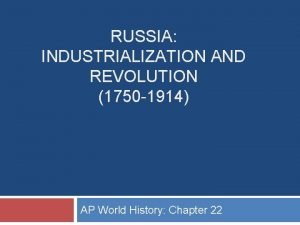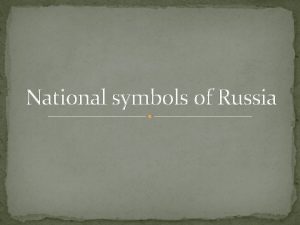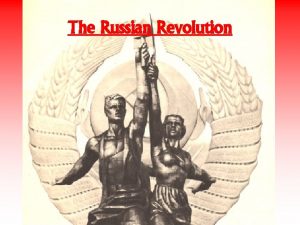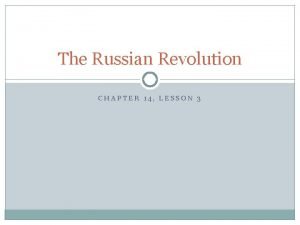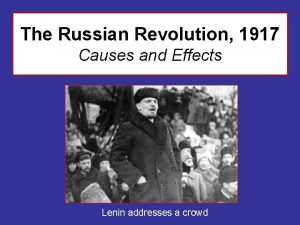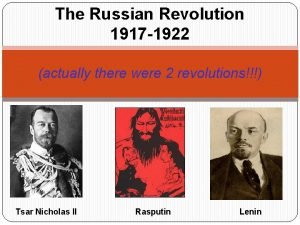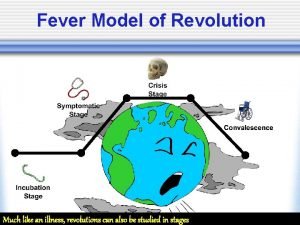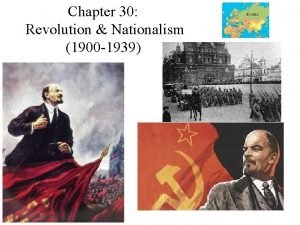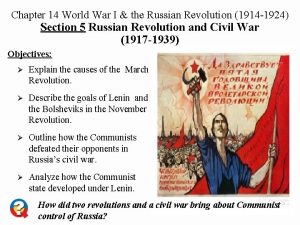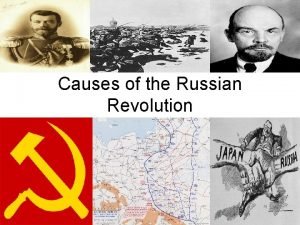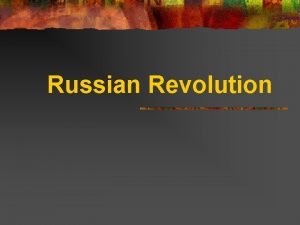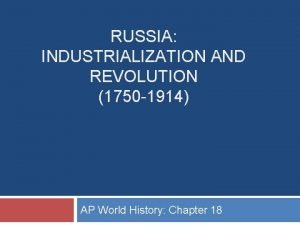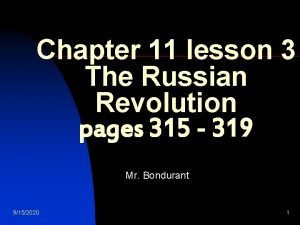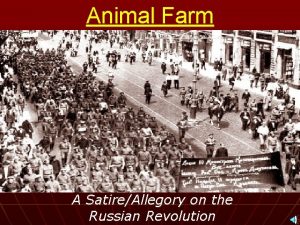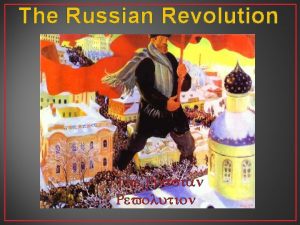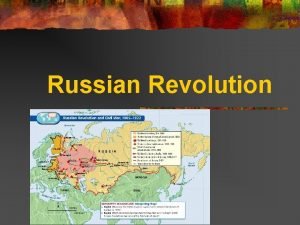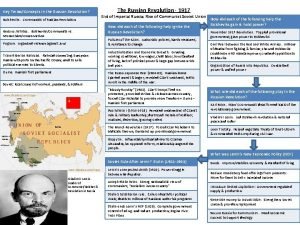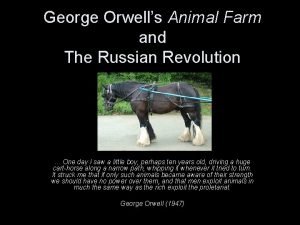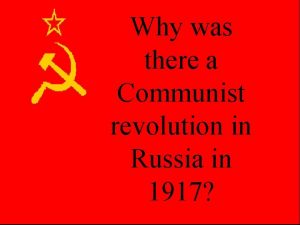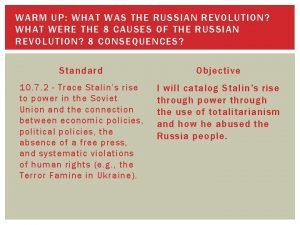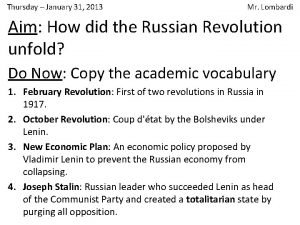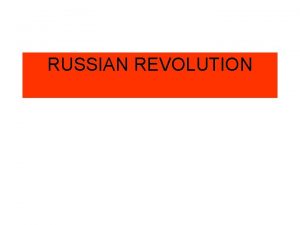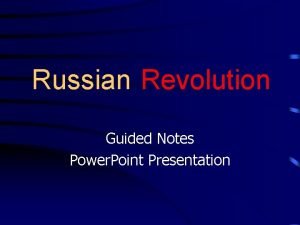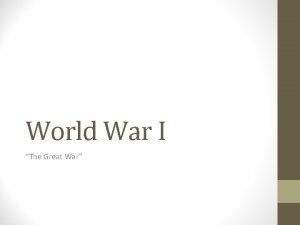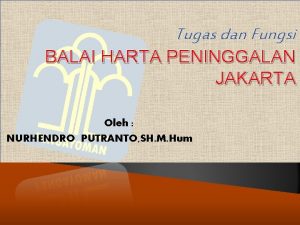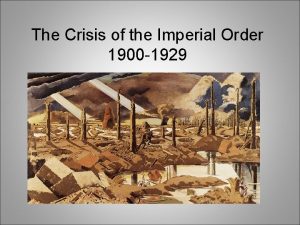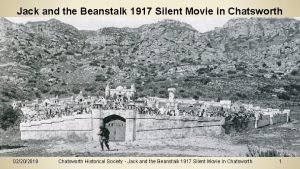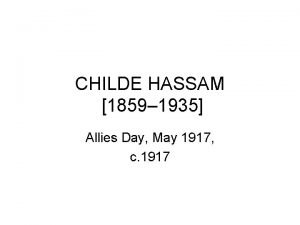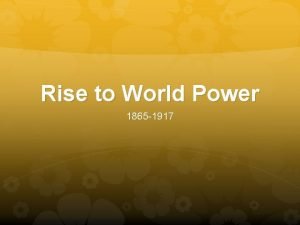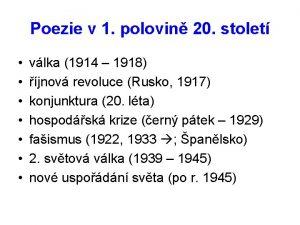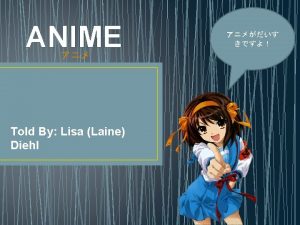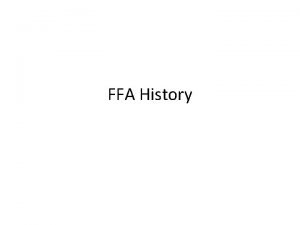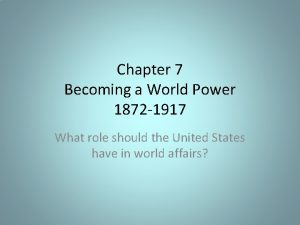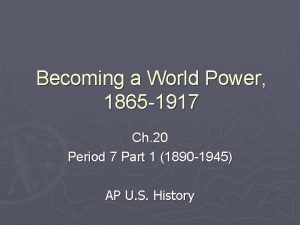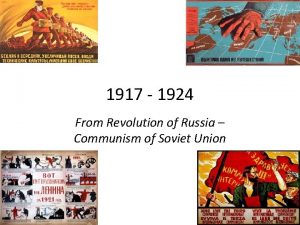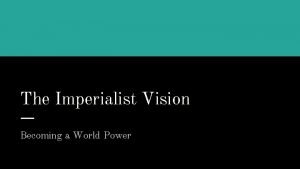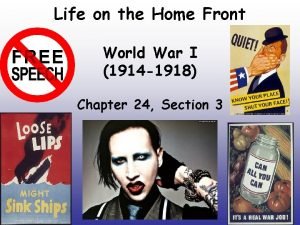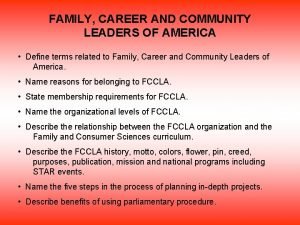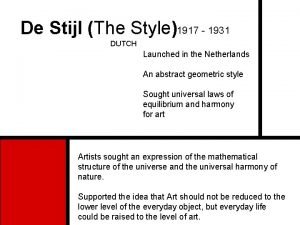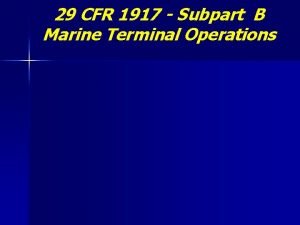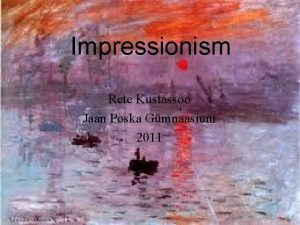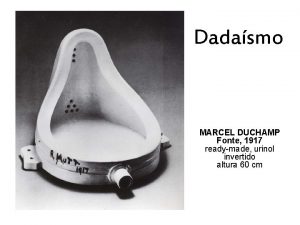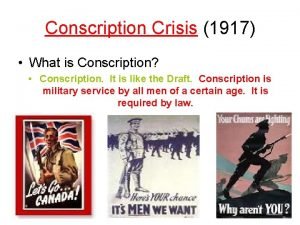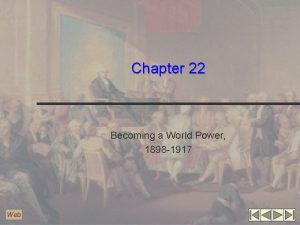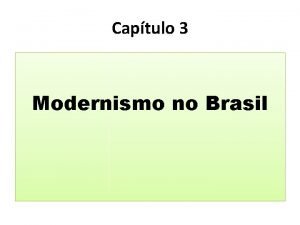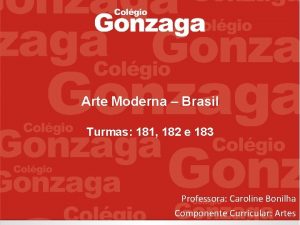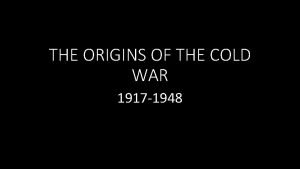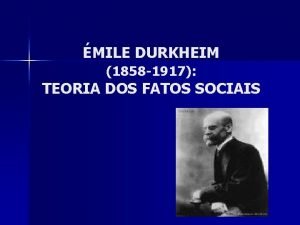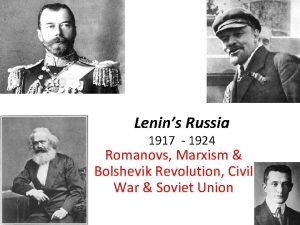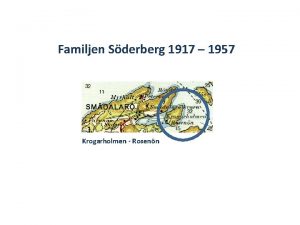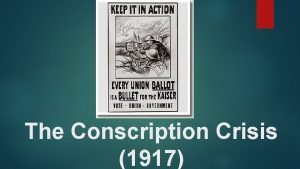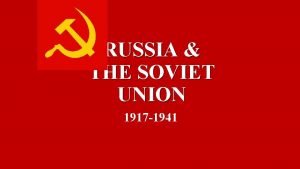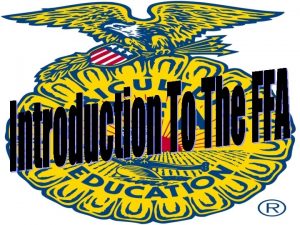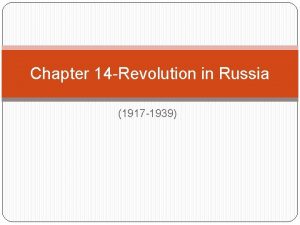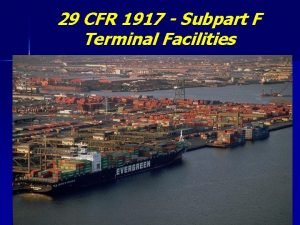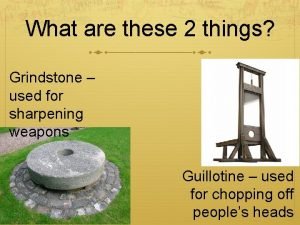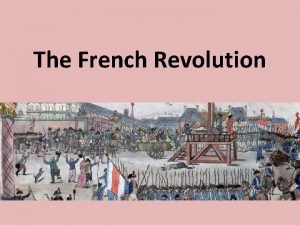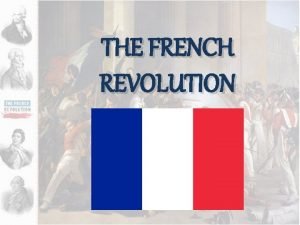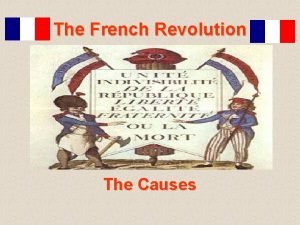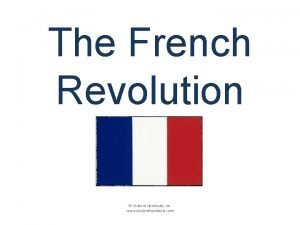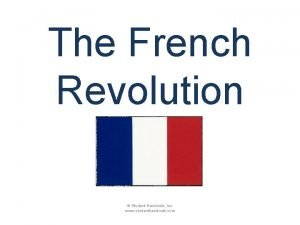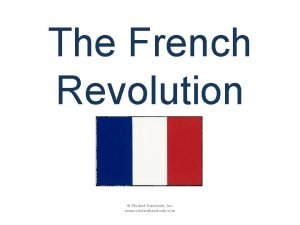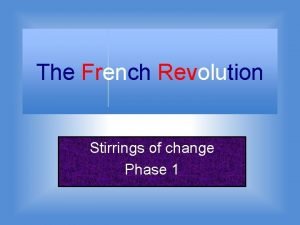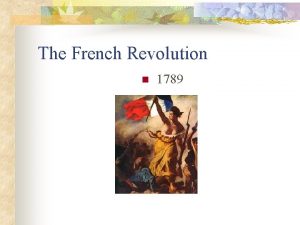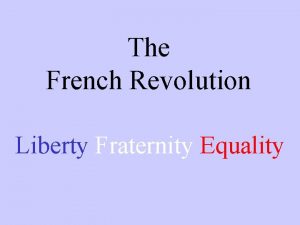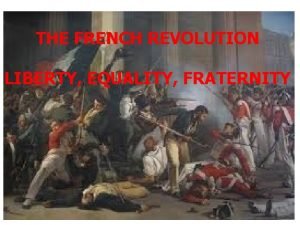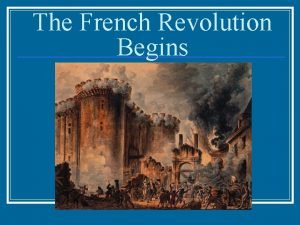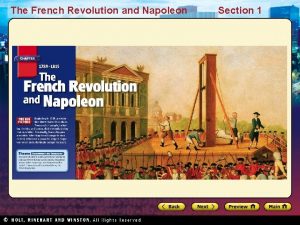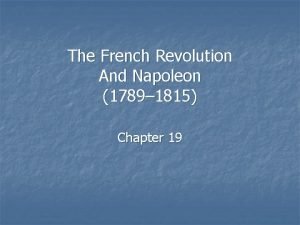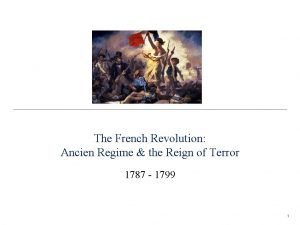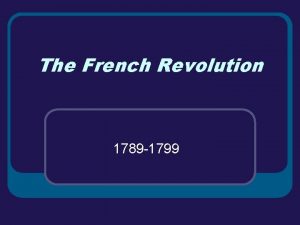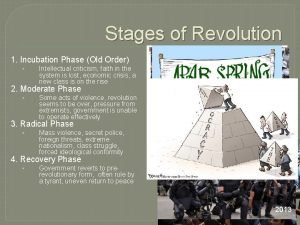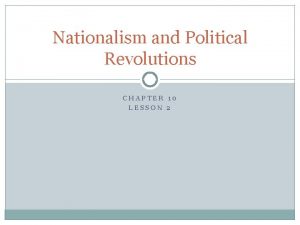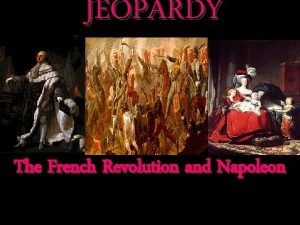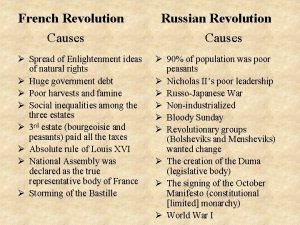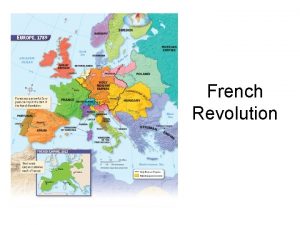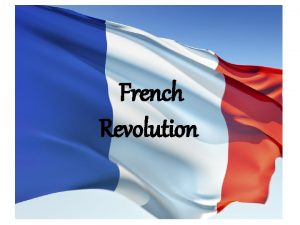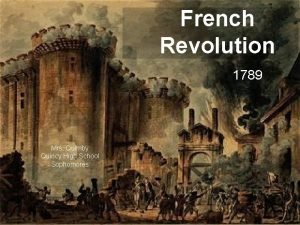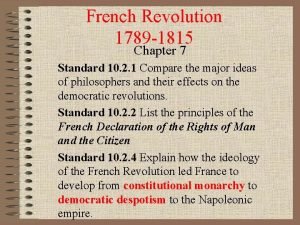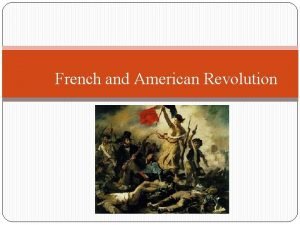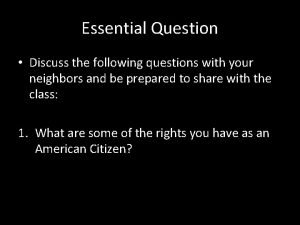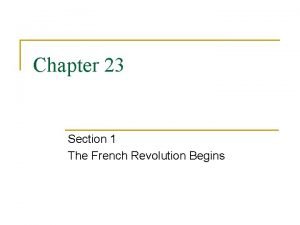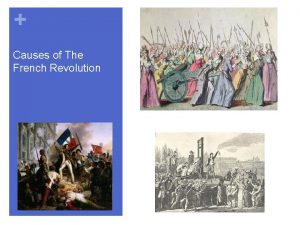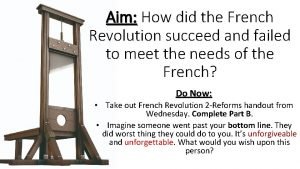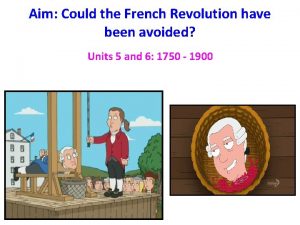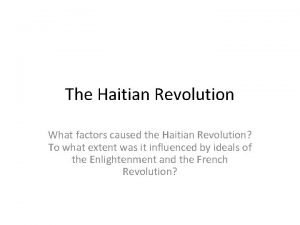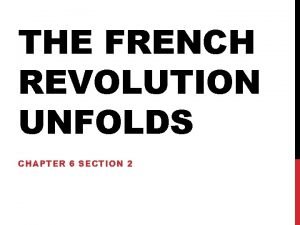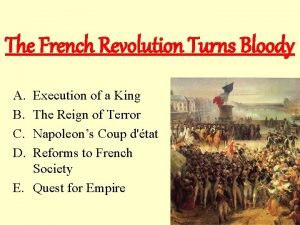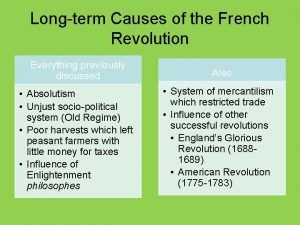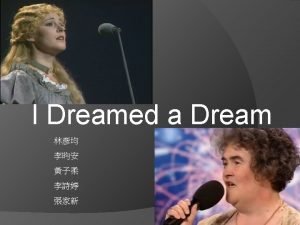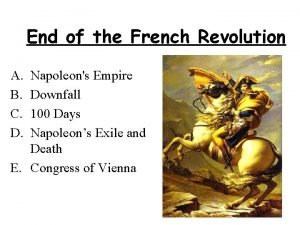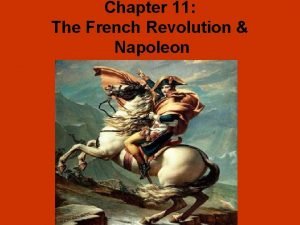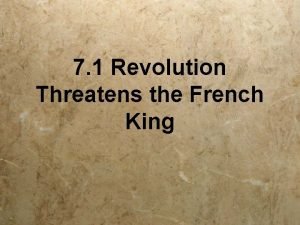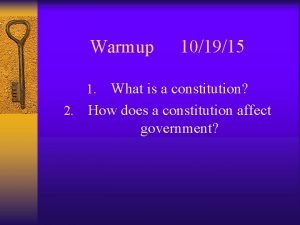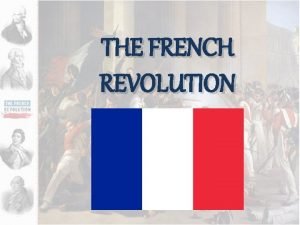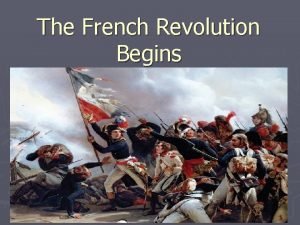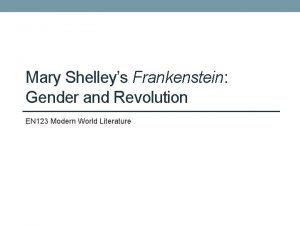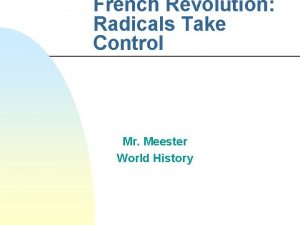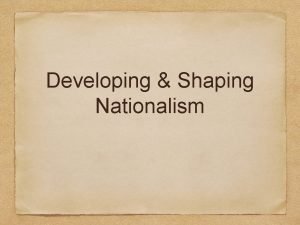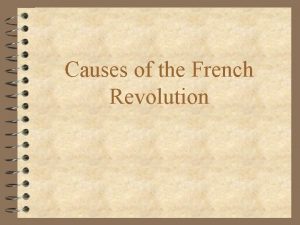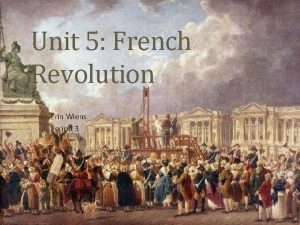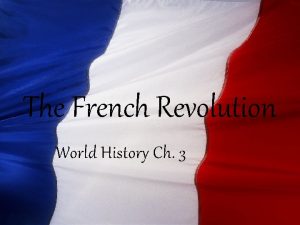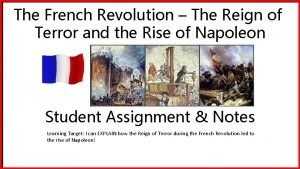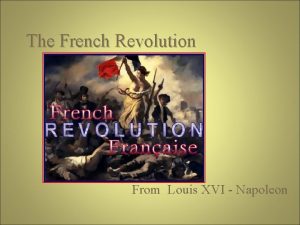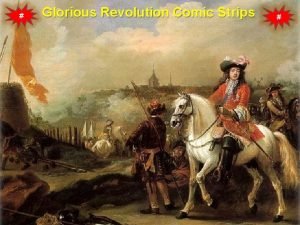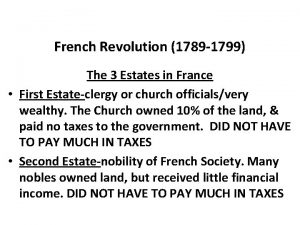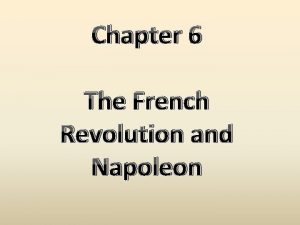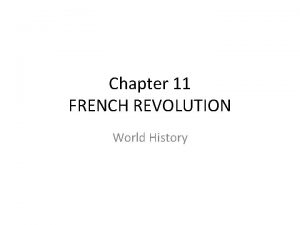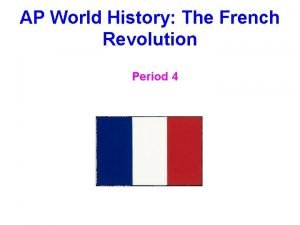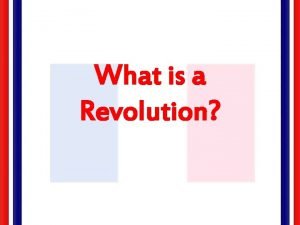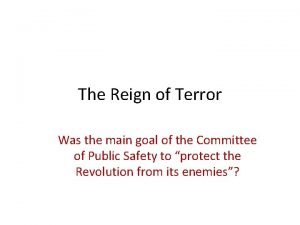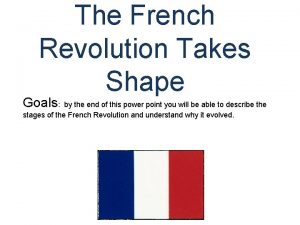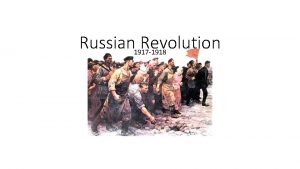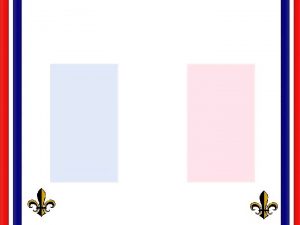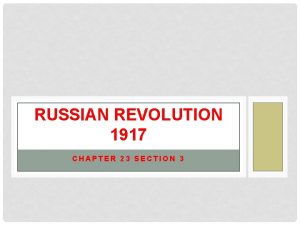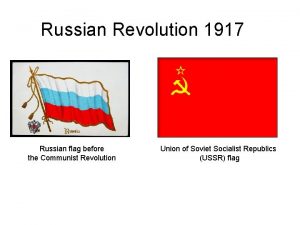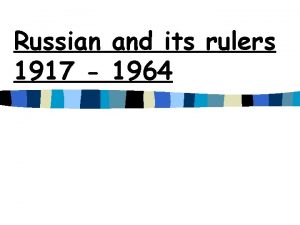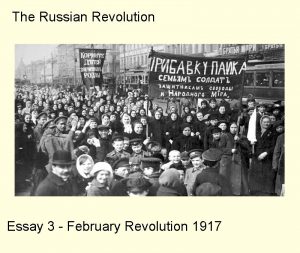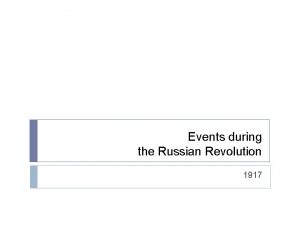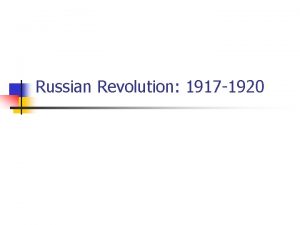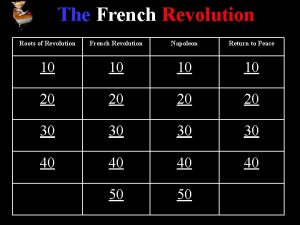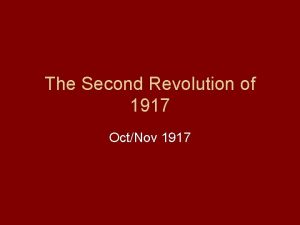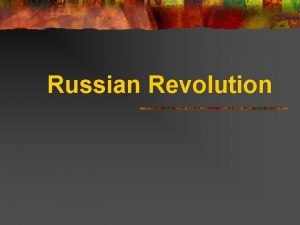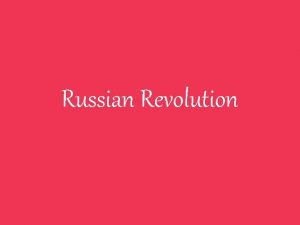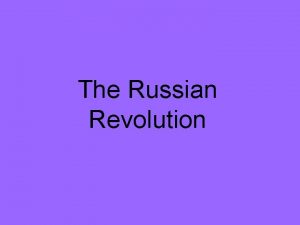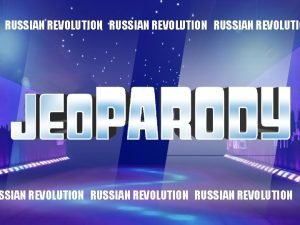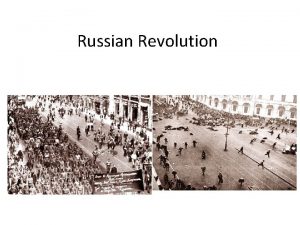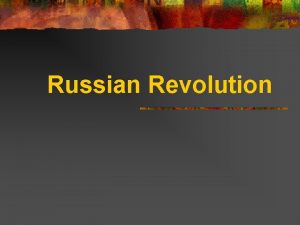The Russian Revolution 1917 Like the French Revolution




























![Russo-Japanese War [19041905] Russo-Japanese War [19041905]](https://slidetodoc.com/presentation_image_h/e40520c9c94b6ad2c69c64c72d0fb530/image-29.jpg)




















































































































- Slides: 145

The Russian Revolution, 1917 Like the French Revolution, the Russian Revolution sought not only to overthrow a government but to remake an entire society. Unlike the French Revolution, it succeeded.

INTRODUCTION • This mighty nation covered one-sixth of the land surface of the globe, and was populated by almost 150 million people of more than a hundred different nationalities. The Symbol for Imperial Russia

19 th Century Russia was…. . • • Only 40% ethnic Russians 80% were peasants – subsistence farmers 60%+ = illiterate Life expectancy = 40 Low tech and low investment Land ownership rare Land owned by OBSCHINA (Commune)

…still a feudal country. • Peasants could not leave the commune without the consent of the elders • Drought and crop failure common • 1891 = famine + cholera and typhus = 400, 000 dead • 1890 – 64 % of peasants called up for military service were declared unfit.

th 19 Century Russian Social Hierarchy

Russian Krestyanin (Peasant)

Cause 1: Suffering under Autocracy The people suffer under the cruel Czars, who use their secret police to kill or arrest anyone who dares to oppose his autocracy (=total power).

The oppressive rule of most 19 th-century czars caused widespread social unrest for decades. Anger over social inequalities & the ruthless treatment of peasants grew. The czar’s unfair governing sparked many violent reactions.

Nevertheless, many Russians worshipped the Tsar as God’s representative on earth. Peasants typically had a picture of the Tsar on a wall of their hut.

An engraving depicting the assassination of Czar Alexander II on March 13 th, 1881.

Alexander’s son witnesses his father’s assassination and becomes Czar Alexander III

Alexander III: The “Russian Bear” (1881 -94) “The Russians need the whip”

“Russification” under Alexander III l Mandatory Russian language in a multinational empire l Persecution (pogroms) of Jews

The victims, mostly Jewish children, of a 1905 pogrom in Dnipropetrovsk

Alexander’s Policies (Cont. ) l Elimination of zemstvos l Secret police generate mass arrests, deportations, executions l Here’s a typical secret police file

One radical hung in 1887 was this 17 -year-old’s brother: l He is Vladimir Ilyich Ulyanov, better known as Lenin, whom Alexander should have hung…

In 1894, when Nicholas II became czar, he announced, “The principle of autocracy will be maintained by me as firmly & unswervingly as by my father (Alexander III)” He Refused to surrender any of his power.

Czar Nicholas II

Cause 2: Suffering from Industrialization Factory workers suffer from: low wages, long hours, and brutal working conditions.

Broom Factory, 1910

Putilov Machine Works

Russian Steel Workers

Cause 3: Spread of Marxism With the help of revolutionaries like Lenin and Trotsky, Karl Marx’s idea of a proletariat (worker’s) revolution becomes increasingly popular.

Karl Marx, from Economic and Philosophic Manuscripts (1844) The worker becomes all the poorer the more wealth he produces, the more his production increases in power and range. The worker becomes an ever cheaper commodity the more commodities he creates. With the increasing value of the world of things proceeds in direct proportion to the devaluation of the world of men. Labour produces not only commodities; it produces itself and the worker as a commodity -- and does so in the proportion in which it produces commodities generally.

Lenin

Leon Trotsky

Cause 4: Loss in Russo. Japanese War (1905) This humiliating defeat makes the Czar look weak and leads to widespread protests.

1904: How Russia expected to beat Japan
![RussoJapanese War 19041905 Russo-Japanese War [19041905]](https://slidetodoc.com/presentation_image_h/e40520c9c94b6ad2c69c64c72d0fb530/image-29.jpg)
Russo-Japanese War [19041905]

The Battle of Tsushima, May 1905: Japanese Navy sinks Russian fleet

Russia Is Humiliated

Cause 5: Bloody Sunday (1905) The massacre of unarmed protesters outside the Czar’s palace leads to strikes throughout Russia.

Unrest Among the Peasants & Urban Working Poor Father Georgi Gapon: Leader of the People OR Police Informer?

January 9 th, 1905: 200 killed, 800 wounded, the first victims of the Russian revolution

Bloody Sunday January 22, 1905 The Czar’s Winter Palace in St. Petersburg

“Bloody Sunday” (9 Jan. 1905)

3 months later: “Bloody Sunday”

Potemkin Mutiny, 1905

1905 Protests

General Strike (17 October 1905)

Cause 6: Suffering from WWI Millions of Russians die from battle, hunger, and disease. The economy is in ruins. People are desperate for change.

Russia cannot wage an industrial war

MAP: The Eastern Front

World War I: “The Last Straw” n n War revealed the ineptitude and arrogance of the country’s aristocratic elite The Russian “Steam Roller” Corrupt military leadership and contempt for ordinary Russian people Average peasant has very little invested in the War

World War I (cont) Poorly supplied troops n Result: Chaos and Disintegration of the Russian Army --Battle of Tannenberg (August, 1914) n Spreading Discontent n

World War I § § § Russia unprepared for war Not enough supplies (food, weapons, clothing) Army poorly organized Soldiers didn’t understand why they were fighting Tsar Nicholas II and his ministers provided poor leadership and organization

Devastation of War – Ukraine

In 1915, the Tsar will take personal command of the army • And that means leaving a Russia ruled by Alexandra and her closest adviser, Rasputin

The Collapse of the Imperial Government • Nicholas left for the Front —September, 1915 • Alexandra and Rasputin throw the government into chaos • Alexandra and other high government officials accused of treason

Alexis: The Tsarevich, or heir to the throne • Only Rasputin can stop the boy’s hemorrhaging, the product of the hemophilia inherited from his greatgrandmother, Victoria

Because of that strange power… • The starets, or monk, becomes, as Alexandra puts it, “Our Friend, ” and a powerful influence on the Romanovs • He is also a promiscuous drunk—but the Tsarina refuses to listen to any criticism of him

In 1915, Nicholas moved his headquarters to the war front. His wife Czarina Alexandra, ran the government while he was away. She ignored the czar’s chief advisers & instead she fell under the influence of the self-described “holy-man” Rasputin. Czarina Alexandra Rasputin claimed to have magical healing powers. “Wonderful tales were told of how the stares could look into every man’s soul, foresee the future, and heal the sick by a glance of his eyes or a touch of his hands. ”

Cause 7: Czar Nicholas II refused to share power Czar Nicholas II is a weak leader. He clings to power despite the obvious need for change.

The Last Tsar: Nicholas II (1894 -1917)

Nicholas II’s personality l Terrorized by his father: He wants to please Papa… l But he’s a gentle family man, lacks a forceful personality—Nicholas is eerily similar to Louis XVI—and to Charles I of England l Uh-oh.

Nicholas II’s disasters l One of them is his marriage—to Alexandra of Hesse, “that German woman; ” she, like Marie Antoinette, is hated by many Russians

The marriage itself… …is a ‘love match’ The two are deeply committed to each other, and they raise a beautiful family.

Their coronation (Seen here: Can you find the new Tsar’s Mom? ) is not a good omen

Alexis: Alexandra’s Son with Hemophilia

Hemophilia & the Tsarevich

Event 1: February 23 rd Female textile workers in Petrograd, go on strike because of a shortage of bread. Soon they are joined on the streets by half of the cities 400, 000 workers.

Petrograd

February Bread Riot (Painting)

St. Petersburg Bread Rioters, 1917

Armed citizenry

February 1917: Crowds in front of the Royal Palace

Event 2: February 27 Soldiers brought in to put down rioters instead mutiny, join the rioters, and arrest their commanding officers.

Petrograd, February Revolt of the Pavlovsky Guards Regiment

Arrest of generals

Event 3: March 1 The so called “provisional government”, led by Alexander Kerensky is formed.

Alexander Kerensky • Kerensky, a moderate socialist, will emerge as the leader of a February 1917 revolution against the Tsar

The Provisional Government

Event 4: March 2 Czar Nicholas II, is forced to abdicate (give up power) while sitting in a railroad carriage, ending 600 years of Czarist rule in Russia.

Abdication of Nicholas II

Event 5: March 8 The provisional government passes civil rights laws but decides to continue fighting WWI.

Provisional Government § Declared all Russian citizens equal § Freedom of speech, religion, press, and § § assembly given to all citizens Unions and strikes legal Planned on continuing war Provisional Government made these promises, but asked people to wait People tired of waiting and listened more and more to the revolutionaries

But Kerensky refuses to pull Russia out of the War—he will, in fact, launch disastrous new offensives

Event 6: April 3 Vladimir Lenin returns from exile and soon dominates the Bolsheviks.

Lenin Returns to Russia The Germans arrange for Lenin’s return to Russia after many years of exile. The Germans believe that Lenin & his Bolshevik supporters would cause unrest in Russia & hurt the Russian war effort. Traveling in a sealed railway boxcar, Lenin reaches Petrograd in April 1917.

Peace, Bread, and Land!

Lenin Addresses the Petrograd Soviet - 1917

Event 7: June Germans crush the Kerensky Offensive. Russia suffers 400, 000 casualties. Many soldiers mutiny and join pro peace Bolsheviks.

Kerensky at the Front

Event 8: July 3 An attempted Bolshevik coup (takeover) of the provisional government fails. Lenin escapes to Finland.

Event 9: August 25 General Kornilov attempts to overthrow the provisional government and form a military dictatorship. Kerensky (leader of provisional government) asks for help from the Bolsheviks and gives them weapons. Kornilov is defeated.

General Kornilov • Lavr Georgiyevich Kornilov (August 18, 1870–April 13, 1918) • was a Russian army general best known for the Kornilov Affair, an unsuccessful military coup he staged against Kerensky's Provisional Government during the 1917 Russian Revolution.

Kornilov Affair n To prevent this takeover, Kerensky freed many Bolshevik leaders from prison and supplied arms to many revolutionaries

Event 10: October 25 Lenin and Bolsheviks make their move. They take over the major government offices in Petrograd. Kerensky and the PG flee. The revolution spreads throughout Russia.

Bolsheviks Storming the Winter Palace


Long Live World October!

What Did Lenin Do Upon Coming to Power? § Immediately proposed an end to War (WWI) (what peasants wanted most was peace) § Proposed the distribution of all land to peasants, landowners would not be paid for land taken from them § Lenin’s proposals adopted

THE RUSSIAN REVOLUTION AND THE WORLD • Lenin and Trotsky said that the goal of socialism in Russia would not be realized without the success of the world proletariat in other countries, e. g. without German Revolution. • Indeed, a revolutionary wave lasted until 1923.

Effect 1: The Promise Kept Lenin gives all land to the peasants and all factories to the workers

Effect 2: Brest-Litovsk By signing the Treaty of Brest Litovsk, Russia agrees to give Germany huge tracts of land in exchange for peace.

Signing the Treaty of Brest-Litovsk

The Treaty of Brest-Litovsk 1918 Russia Estonia Germany . Latvia Lithuania Ukraine Brest-Litovsk Russian territory ceded to Germany

Effect 3: The Crack Down The Bolsheviks, now renamed the Communists, brutally crack down on anyone deemed an enemy of the revolution, killing thousands and sending thousands more to Gulags, prison camp. The Communists will rule over Russia until 1991.

“Red Terror, ” Summer 1918

Like the Czars he helped overthrow, Lenin established a secret police (the Cheka). He also created a system of Gulags (prison camps where he sent anyone who dared speak against the people’s revolution.

The Gulag Archipelago by Alexander Solzhenitsyn

Effect 4: Civil War The Red Army (Bolsheviks) fight the White Army (Anti. Bolsheviks) for the future of Russia. Fifteen million die. The Red Army prevails.

November 1917 Election Results Party Votes Total (all Russia) 44, 218, 55 Socialist Revolutionaries 37% (48% including Ukrainian bloc) Peasant 0. 6% Bolshevik Social Democrats 24% Menshevik Social Democrats 3% Other Socialist Parties 1% Kadets 5% Cossack Party 2%

Civil War § After signing peace treaty, Bolsheviks § § § faced armed resistance to their rule Civil war lasted from 1918 to 1921 Some non-Russian nationalities took up arms to win independence from Russia Great Britain, France, and the USA sent troops to Russia to defeat Bolsheviks because they did not want these ideas of revolution spread around the world Fight by Bolsheviks to establish communism in Russia, which was renamed the Russian Soviet Federated Socialist Republic (USSR) in 1918 Bolsheviks changed their name to the Communist Part Bolsheviks defeated their enemy’s in 1921

Results of Civil War § Much of Russia in ruins § Cities, land, factories destroyed after almost eight years of fighting § Millions died or fled country § Bolsheviks had mammoth task of rebuilding country

And throw in the U. S. Army (1918 -20)

Effect 5: The Last Czar Fearing the White Army will rescue and then rally around the Czar, the Bolsheviks execute Nicholas, his wife, and five children.

During the Civil War, the Romanov family… …is kept under house arrest by the Bolsheviks

Olga

Tatiana

Marie

Anastasia

From the family album

Their last home; it was torn down in the 1970 s

Today, All Saints Church stands on the site of the home

Lenin worries that the family will provide hope to the Whites, some of whom want a return to monarchy • In the summer of 1918, he orders the Cheka, or secret police, to eliminate them.

Murder of the Romanovs, 1918

The basement of the home after the murders

The family’s remains, uncovered in 1991

Lenin himself will die only four years later • But not before the Bolsheviks have crushed the Whites—the Bolshevik revolution is secured.

Lenin was embalmed and put on permanent display in the Lenin Mausoleum in Moscow.

Before he dies, Lenin warns the Bolshevik leadership about the treachery of one of their own: Joseph Stalin …and that is the quality that will enable Stalin to become the master of Russia, from 1928 until 1953

Power Struggle after Lenin’s Death and Stalin’s Rule n n n Forced collectivization “The Great Famine” “The Great Terror” Purges Gulag



THE NEW FLAG • Symbolized the union between the workers (hammer) & the peasants (sickle)

The first state emblem of Soviet Russia: “Workers of all lands, unite!”

Can you identify these important figures from the Russian Revolution AND briefly describe the role each played in the revolution? Note: These will be on the quiz.


Name: Czar Nicholas II Role: Last Czar / Refused to give up power


Name: Vladimir Lenin Role: Led the Bolshevik revolution of 1917


Name: Leon Trotsky Role: Led the Red Army to victory in Russian Civil War.


Name: Female Textile Workers Role: Their bread riot in March, 1917 began the Russian Revolution.


Name: General Kornilov Role: Attempted coup (takeover) of PG in August, 1917 failed.


Name: Rasputin Role: Controlled Russia through Czar’s wife while Czar was at front.


Name: Alexander Kerensky Role: Led PG (Provisional Government) from March. October 1917


Name: Karl Marx Role: His ideas of a worker’s revolt inspired the Russian Revolution.

End
 Russian industrialization ap world
Russian industrialization ap world Triple alliance ap euro
Triple alliance ap euro Russian revolution vs french revolution
Russian revolution vs french revolution Russian national symbols
Russian national symbols Presumptuous in french
Presumptuous in french March 1917 revolution
March 1917 revolution Economic causes of french revolution
Economic causes of french revolution World war 1 and the russian revolution chapter 27
World war 1 and the russian revolution chapter 27 Lesson 3 the russian revolution
Lesson 3 the russian revolution Causes and effects of the russian revolution
Causes and effects of the russian revolution Czar in russian revolution
Czar in russian revolution How did vladimir lenin influence the russian revolution
How did vladimir lenin influence the russian revolution Russian revolution cartoons
Russian revolution cartoons Fever model stages
Fever model stages Chapter 30 revolution and nationalism worksheet answers
Chapter 30 revolution and nationalism worksheet answers Kzbho6asboc -site:youtube.com
Kzbho6asboc -site:youtube.com Effect of russian revolution
Effect of russian revolution Http://www.history.com/topics/russian-revolution
Http://www.history.com/topics/russian-revolution Russian revolution of 1905 definition ap world history
Russian revolution of 1905 definition ap world history Chapter 11 lesson 3
Chapter 11 lesson 3 How is animal farm a satire on the russian revolution
How is animal farm a satire on the russian revolution The russian revolution
The russian revolution The russian revolution
The russian revolution Russian revolution
Russian revolution Animal farm
Animal farm Introduction of russian revolution
Introduction of russian revolution Russian revolution effects
Russian revolution effects Causes of the russian revolution
Causes of the russian revolution Russian revolution
Russian revolution The russian revolution guided notes
The russian revolution guided notes Selective service act of 1917
Selective service act of 1917 Stbl. 1917 no. 130 jo. 1919 no. 81
Stbl. 1917 no. 130 jo. 1919 no. 81 Europe 1917
Europe 1917 Marcel duchamps
Marcel duchamps 1917 movie map
1917 movie map Allies day may 1917
Allies day may 1917 Becoming a world power 1865-1917
Becoming a world power 1865-1917 Morgenstern trychtýře
Morgenstern trychtýře 1917 anime
1917 anime What act was passed in 1917 ffa
What act was passed in 1917 ffa Becoming a world power, 1872–1917
Becoming a world power, 1872–1917 Chapter 20 becoming a world power notes
Chapter 20 becoming a world power notes Marxists.org
Marxists.org Chapter 5 lesson 1 the imperialist vision answers
Chapter 5 lesson 1 the imperialist vision answers The espionage act of 1917
The espionage act of 1917 Jos slovick wayfaring stranger
Jos slovick wayfaring stranger Smith hughes act ffa
Smith hughes act ffa Fccla february 1917
Fccla february 1917 De stijl 1917-1931
De stijl 1917-1931 29 cfr 1917
29 cfr 1917 Sobre a exposição de anita malfatti em 1917
Sobre a exposição de anita malfatti em 1917 Rete kustassoo
Rete kustassoo Urinol de duchamp
Urinol de duchamp What was the conscription crisis of 1917
What was the conscription crisis of 1917 1917
1917 Os modernistas dos anos 1920 frequentemente
Os modernistas dos anos 1920 frequentemente Sobre a exposição de anita malfatti em 1917
Sobre a exposição de anita malfatti em 1917 1917
1917 Durkheim fato social
Durkheim fato social Marcel duchamp fontaine prix
Marcel duchamp fontaine prix Russia 1917
Russia 1917 Usa bil 1917-1957
Usa bil 1917-1957 Conscription crisis 1917
Conscription crisis 1917 1917
1917 Leslie appelgate
Leslie appelgate National vocational act
National vocational act 1917 succession act
1917 succession act 29 cfr 1917
29 cfr 1917 In french in french
In french in french Grindstone french revolution
Grindstone french revolution French revolution causes and effects
French revolution causes and effects French revolution timeline
French revolution timeline French revolution calender
French revolution calender Committee of public safety
Committee of public safety 4 stages of french revolution
4 stages of french revolution Economic causes of the french revolution
Economic causes of the french revolution Short term causes of the french revolution
Short term causes of the french revolution Causes and effects of the french revolution
Causes and effects of the french revolution October 6 1789 french revolution
October 6 1789 french revolution Causes of french revolution
Causes of french revolution The french revolution timeline
The french revolution timeline Fraternity in french revolution
Fraternity in french revolution What was the reason for the french revolution
What was the reason for the french revolution Four phases of french revolution
Four phases of french revolution French revolution causes
French revolution causes French revolution political cartoons explained
French revolution political cartoons explained French revolution essential questions
French revolution essential questions The french revolution begins chapter 7 section 1
The french revolution begins chapter 7 section 1 Causes and effects of french revolution
Causes and effects of french revolution Four phases of the french revolution
Four phases of the french revolution The ancien regime
The ancien regime Storming of the bastille cartoon
Storming of the bastille cartoon Stages of french revolution
Stages of french revolution What was an immediate cause of the 1789 french revolution
What was an immediate cause of the 1789 french revolution French revolution causes and effects
French revolution causes and effects French revolution causes and effects
French revolution causes and effects Nationalism and political revolutions lesson 2
Nationalism and political revolutions lesson 2 French revolution jeopardy
French revolution jeopardy French revolution graphic organizer
French revolution graphic organizer Enlightenment ideals
Enlightenment ideals French revolution location
French revolution location The causes of the french revolution
The causes of the french revolution French revolution women's march
French revolution women's march French revolution
French revolution American revolution effects
American revolution effects Discuss the following questions
Discuss the following questions Chapter 23 section 1
Chapter 23 section 1 The causes of the french revolution
The causes of the french revolution 18th century porn pamphlets
18th century porn pamphlets The causes of the french revolution
The causes of the french revolution Did french revolution succeed
Did french revolution succeed French revolution summary
French revolution summary What factors caused the french revolution
What factors caused the french revolution Chapter 6 section 2 the french revolution unfolds
Chapter 6 section 2 the french revolution unfolds French revolution bloody
French revolution bloody American revolution causes and effects
American revolution causes and effects Les miserables background
Les miserables background French revolution abc
French revolution abc Chapter 11 the french revolution and napoleon
Chapter 11 the french revolution and napoleon Revolution threatens the french king
Revolution threatens the french king Flocabulary french revolution
Flocabulary french revolution Objectives of french revolution
Objectives of french revolution The french revolution begins
The french revolution begins The three estates of french revolution
The three estates of french revolution Frankenstein french revolution
Frankenstein french revolution Radicals take control french revolution
Radicals take control french revolution Define collective consciousness
Define collective consciousness Chapter 23 the french revolution and napoleon
Chapter 23 the french revolution and napoleon French revolution recipe
French revolution recipe Oath of the horatii french revolution
Oath of the horatii french revolution Estate french revolution
Estate french revolution France constitutional monarchy
France constitutional monarchy French revolution
French revolution Reign of terror mini q answers
Reign of terror mini q answers French revolution symbol
French revolution symbol Jack and jill french revolution
Jack and jill french revolution 05.05.1789
05.05.1789 French revolution comic strip
French revolution comic strip Three estates of french revolution
Three estates of french revolution French revolution
French revolution The french revolution and napoleon section 3 quiz
The french revolution and napoleon section 3 quiz Introduction of french revolution
Introduction of french revolution Tennis court oath definition ap world history
Tennis court oath definition ap world history What is revolution
What is revolution What was the goal of the reign of terror
What was the goal of the reign of terror Goals of the french revolution
Goals of the french revolution
